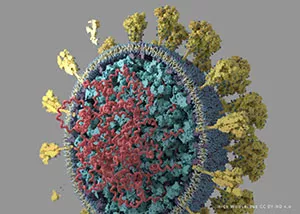
U of T’s resource for original COVID-19 visual media
In the early weeks of the COVID-19 pandemic, a significant role for visual media has emerged. Illustrations, animations, and data visualizations are being widely circulated on social platforms and in the media to share clinical and scientific findings and explain to the public how social distancing slows the spread of the SARS-CoV-2 virus.
Creating science- and evidence-based visual media is the role biomedical communications specialists play in making meaning from complex information in order to connect with many audiences, including the general public.
“Rather than live in fear or ignore messaging due to a lack of comprehension, we provide tools that can empower the public to act responsibly from the perspective of understanding,” says Jodie Jenkinson, director of the Master of Science in Biomedical Communications at the University of Toronto.
Making complex information digestible
On March 30, Jenkinson and fellow faculty Derek Ng and Nicholas Woolridge launched the COVID-19 Visual Media Resource. The Resource is available to the public through the Biomedical Communications program’s website.
“The COVID-19 Resource is intended for anyone looking for digestible, visualized information about the COVID-19 disease or the SARS-CoV-2 virus which causes it,” says Woolridge, associate professor and past director of the program.
The Resource includes a wide variety of visual media which are targeted to a range of audiences. Some would be more useful for a clinical or research audience, and some are directed at the general public, Woolridge says. “Scientists who are making presentations, educators who are teaching, individuals just trying to learn more and journalists who are communicating stories about COVID-19 can all use these resources.”
The media include: a public service animation by Woolridge vital to conveying the idea of flattening the curve in the early weeks of the pandemic; a coronavirus comic by Christine Shan, a second year Biomedical Communications graduate student, which explains through graphics how the COVID-19 virus infects humans; to an evidence-based representation also by Woolridge of the internal structure of the virus in relation to its external structure.
“The animation of the virus structure is posted in broadcast quality, and is being made available as free to use even in a commercial context,” says Woolridge.
Felix Dongwhi Son, a recent graduate of the program, lives in South Korea where the pandemic is also being experienced. He created a number of free visual resources for journalists that can be found in the COVID-19 Resource.
The resource also includes links to trusted external sources for visualizations.
"Scientific and medical illustrators make their living translating scientific evidence into accessible visual media for different audiences and uses. I am inspired by how they are willing to share their work to help fight the spread of COVID-19,” says Ng, biochemist and assistant professor of molecular visualization.
Faculty, students and alumni of the Biomedical Communications program who create referenced, shareable media, especially for a public audience, and who wish to add their work to the COVID-19 Resource should contact Nicholas Woolridge.
Critical need for reliable information
“Without communications devices such as these, I fear that there could be potentially important gaps in communication between public health agencies, epidemiologists, healthcare providers, and the public,” says Jenkinson.
"By rallying to develop resources and make them freely available to others, we hope that our community is helping to provide clear and accessible information at this time when reliable communication is critically needed.”
Contacts
For enquiries, please contact:
Nicholas Woolridge
n.woolridge@utoronto.ca
Maeve Doyle
maeve.doyle@utoronto.ca
